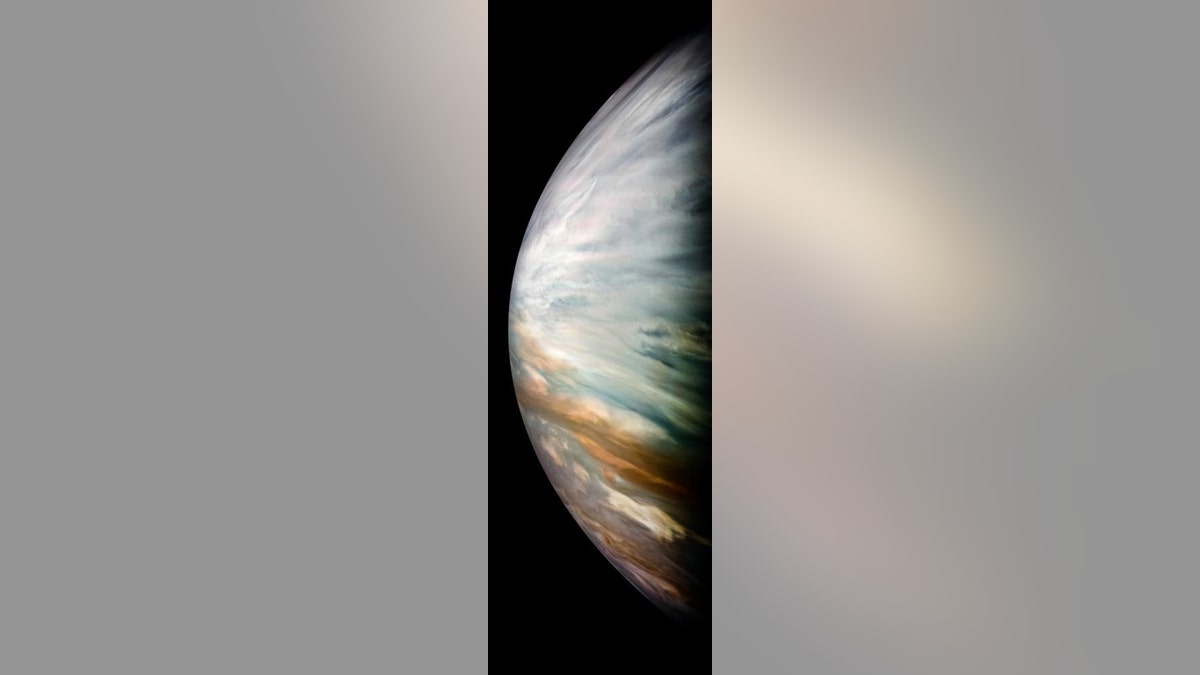Fox News Flash top headlines for Feb. 21
Fox News Flash top headlines are here. Check out what's clicking on Foxnews.com.
The largest planet in the Solar System, Jupiter has a treasure trove of information for astronomers to research and observe. A new study states that the gas giant also contains water in its atmosphere.
Using data from the Juno orbiter, there is at least 0.25 percent water in the planet's atmosphere, notably near the equator, NASA JPL wrote in a blog post.
"Just when we think we have things figured out, Jupiter reminds us how much we still have to learn," said Scott Bolton, Juno principal investigator, in the statement. "Juno's surprise discovery that the atmosphere was not well mixed even well below the cloud tops is a puzzle that we are still trying to figure out. No one would have guessed that water might be so variable across the planet."

Thick white clouds are present in this JunoCam image of Jupiter's equatorial zone. At microwave frequencies, these clouds are transparent, allowing Juno's Microwave Radiometer to measure water deep into Jupiter's atmosphere. The image was acquired during Juno's flyby on Dec. 16, 2017. (Credit: NASA/JPL-Caltech/SwRI/MSSS/Kevin M. Gill)
EXTRATERRESTRIAL LIFE ON EUROPA OR ENCELADUS COULD BE 'INDIGENOUS,' STUDY SAYS
The researchers used data from Juno's first eight flybys of Jupiter to come up with their findings.
"We found the water in the equator to be greater than what the Galileo probe measured," Cheng Li, a Juno scientist at the University of California, Berkeley, added. "Because the equatorial region is very unique at Jupiter, we need to compare these results with how much water is in other regions."
NASA JPL stated these are the first findings on the presence of water since the 1995 Galileo mission "suggested Jupiter might be extremely dry compared to the Sun." The comparison is not based on liquid water, but rather the presence of oxygen and hydrogen, the agency explained.
NASA MISSION TO EUROPA COULD 'POSSIBLY SENSE LIFE'
Getting an accurate estimate on the total water amount in the gas giant's atmosphere "has been on the wish lists of planetary scientists for decades," NASA JPL wrote in the blog post, adding that it "represents a critical missing piece to the puzzle of our solar system's formation."
Scientists believe Jupiter was the first planet to form and it houses gas and dust that are not a part of the sun.
The research was published in the scientific journal Nature Astronomy.
In November, an international research team detected water vapor above the surface of Jupiter’s moon Europa for the first time. It's unclear what the oceans on Europa are made up of, but the Hubble Space Telescope detected the presence of sodium chloride on its surface, according to a study published in June.
The conditions on Europa have been previously likened to exoplanet Barnard B, a "super-Earth" 30 trillion miles from Earth. It likely has a surface temperature of roughly 238 degrees below zero and may have oceans underneath its icy surface, according to a July 2018 statement from NASA.
NASA is launching a mission to Europa within the next decade, a trek that could answer whether the icy celestial body could be habitable for humans and support life.
CLICK HERE TO GET THE FOX NEWS APP
Fox News' James Rogers contributed to this story.

